Navigating the Site Development Process
by Beth H. Land, CEcD, on Sep 27, 2018 2:46:32 PM
The industrial real estate market across the United States continues to tighten, making it difficult for communities to attract new jobs and investment. Economic developers are getting creative with site and product development tactics to encourage economic growth. This article looks at how four different communities navigated the site development process, and their success stories. These case studies demonstrate how thoughtful planning and calculated risk in site development resulted in considerable new investment and jobs for the communities. The article also offers key steps and considerations for starting the site development process.
There is little that is more frustrating to an economic developer than having high levels of prospect activity and having no buildings or sites to show. Exacerbating the issue is that companies’ deadlines to select a site and bring products to market are getting shorter and shorter. To compete for jobs and investment, economic developers are becoming more engaged and taking a leadership role to provide viable real-estate options to prospects. This article outlines four case studies of communities that have taken on risk in real estate development projects to encourage growth and investment. While there are certainly political and financial risks to development, the pay-off can bring huge returns fora community.
It is important to note that economic developers should consider the competitive landscape within which they operate and complete a cost/benefit analysis of tackling real estate development projects within their community. The end goal of these projects is to reduce the schedule and financial risks for companies making a location decision. By doing so, the community is in a better position to compete for the project. The first case study takes an in-depth look at how Huntsville, Alabama, positioned itself to win the Toyota-Mazda automotive assembly plant.
COMMUNITIES PREPARE FOR SUCCESS IN THE INDUSTRIAL REAL ESTATE MARKET
The industrial real estate market across the United States continues to tighten, making it difficult for communities to attract new jobs and investment. Economic developers are getting creative with site and product development tactics to encourage economic growth. This article looks at how four different communities navigated the site development process, and their success stories. These case studies demonstrate how thoughtful planning and calculated risk in site development resulted in considerable new investment and jobs for the communities. The article also offers key steps and considerations for starting the site development process.
HUNTSVILLE MEGA SITE: Huntsville, Alabama
The first example is within the city limits of Huntsville, Alabama. The Huntsville/Madison County Chamber of Commerce and the Tennessee Valley Authority (TVA) partnered together to prepare a Mega Site for a large Original Equipment Manufacturer (OEM). After the site was a finalist for the Volkswagen project in 2008 and lost to Chattanooga, local leadership knew that they lost because the site was not ready. Local stakeholders spent10 years preparing the site for the next big OEM project. Leaders tackled five issues to prepare the site: property developability, availability, utility infrastructure, transportation, and zoning.
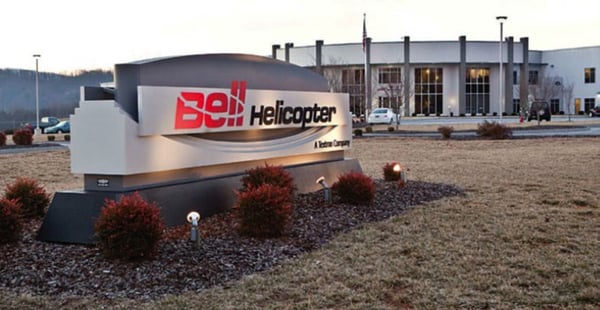 |
| After a multi-jurisdictional team created Tri-County Industrial Park in the 1970s, BellHelicopter was one of the anchor tenants to announce within the park. The park is now home to more than 35 industrial tenants. |
Any time you are dealing with acreage on this scale, it is difficult to assemble land without on-site development impediments (e.g. wetlands, floodplain, easements, etc.). The Huntsville Mega Site was hand-selected because of the limited existing impediments on-site. Due diligence reports (Phase I ESA; wetlands delineation; geotechnical; archaeological and historical investigation; and protected and endangered species) were also completed. If there were any concerns found within the reports, the issues were addressed. Coordinating and paying for due diligence reports on such a large piece of property is an accomplishment itself. Out of 1,252 total acres, studies found that 1,157 acres were developable. This high percentage (92 percent) of developable land allowed for a great deal of flexibility in configuration and master concept planning.
Ensuring the availability of the property can also be cumbersome with Mega Sites due to the scale of the project. Developers are often trying to herd several different ownership groups to agree on terms. It is not unheard of for an industrial property to have 10 to 100 different ownership groups, which can quickly complicate a deal. Given the size of the property, limited developability issues, and the fact that there was only one ownership group, the city of Huntsville coordinated an exclusive option in anticipation of a project. By maintaining this option, the city and county ensured that the Huntsville Mega Site was preserved for a high-impact user. In addition, when Toyota-Mazda requested additional adjacent acreage for their project, Huntsville was aggressive in securing the property to meet project needs.
Mega Site users have robust utility requirements, and local stakeholders completed proactive extensions to make sure that infrastructure at the site could meet the capacity needs of prospects. The Huntsville Mega Site needed a sewer line extension, so the city of Huntsville proactively constructed a gravity sewer line to the property in mid-2015. TVA also constructed a 500-kV substation adjacent to the site. Having the sewer line and substation in place eliminated lengthy schedule risks for Toyota-Mazda.
 |
|
Executives and elected officials gather to celebrate the announcement of the joint Toyota-Mazda automotive assembly plant in Huntsville, Alabama. (from left to right) Greg Canifield, Secretary of Commerce for the State of Alabama; Masamichi Kogai, Mazda Motor CorporationPresident and Chief Executive Officer; Kay Ivey, Governor of the State of Alabama; Akio Toyoda, Toyota Motor Corporation President; Tommy Battle, Mayor of Huntsville; and Mark Yarborough, Commission Chairman of Limestone County. |
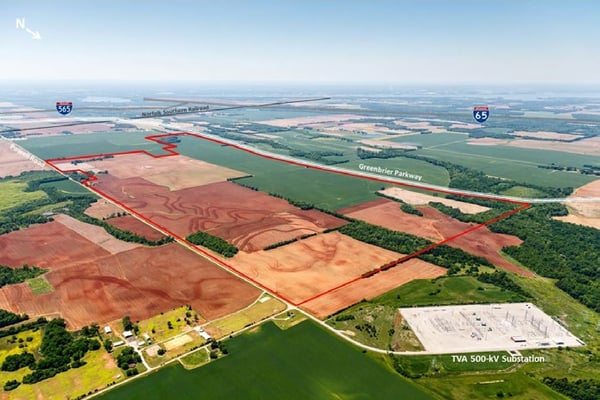 |
|
An aerial of the Huntsville Mega Site where Toyota-Mazda announced their joint automotive assembly plant with $ 1.6 billion in capital investment and over 4,000 new jobs. The new facility will produce 300,000 vehicles annually of the Mazda crossover and Toyota Corolla. |
The city also addressed transportation concerns around the property. The city of Huntsville coordinated a Transportation Master Plan and proactively extended Greenbriar Parkway along the western boundary of the property. This four-lane limited access highway provided additional access to both I-65 and I-565. The city coordinated funds to make these massive infrastructure projects happen, even before they had a project in hand. In addition, locals worked together with Norfolk Southern and the adjacent property owner to prepare rail access to the property. The team put together a detailed proposed plan for extending rail infrastructure that could be completed within a 12-month timeframe and obtained the necessary rights-of-way for the extension. Obtaining right-of-way easements proactively can give prospects confidence that service can be provided. By having a Letter of Intent in place from the adjacent property owner, the economic development team was well-prepared to show Toyota-Mazda that all the details were in place.
Having the property zoned appropriately also shows a prospect that the community has designated the area for industrial growth. Originally, a portion of the Mega Site was within the unincorporated area of Limestone County. While the property within the city limits was zoned “Planned Industrial,” the portion in Limestone County did not have zoning designations. Again, seeing the potential of the property, the city of Huntsville decided to annex the remaining portion of the Mega Site and zoned it “Planned Industrial.” Because of their careful planning, the city of Huntsville will see significant gains in their property tax base when Toyota-Mazda invests within their city limits.
The result of Huntsville’s careful planning was a mammoth economic development win. In January 2018, Toyota-Mazda announced a joint automotive assembly plant at the site. The announcement will include $1.6 billion of investment and 4,000 new jobs and will be a catalyst for the regional economy for generations to come. While all communities do not need to develop a Mega Site, the case study is a good example of how community stakeholders had a vision and took the appropriate steps to land a win.
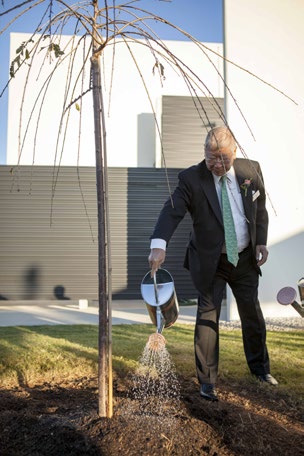 |
|
Denzaemon Sasada, Owner, Chairman and CEO of Marukan Vinegar Co., Ltd., waters the newly planted cherry blossom tree at the grand opening for their new facility in Griffin, GA. The new facility was opened in October 2017 after meeting the Sustainability Checklist criteria of The Lakes at Green Valley industrial park. |
THE LAKES AT GREEN VALLEY: Griffin, Georgia
The Lakes at Green Valley in Griffin, Georgia, is another example of a community that thought outside the-box in terms of site development. The Lakes at Green Valley was a joint effort between the Griffin-Spalding County IndustrialDevelopmentAuthority (GSCIDA)and the Georgia Institute of Technology. Community leaders initiated the project in 2008 and formed a strategic plan. Based on the natural beauty of the land and the nine lakes located on-site, community developers decided to develop and market The Lakes at Green Valley as an eco-friendly industrial park. The green industrial park’s goal is to support greater environmental sustainability at the firm level.
GSCIDA purchased the property, which allowed for direct control over how the property would be developed. The board created a Master Development Plan, incorporating eco-friendly and water conservation initiatives with the nine lakes on-site. The industrial park is made up of 570 acres, with 12 industrial sites. The Master Development Plan estimated 2.5 million square feet of industrial space, as well as a hotel/conference center, retail center, residential area, and 30 acres dedicated to green space. The industrial area offers unique amenities with an outdoorsmen component that includes award-winning bass fishing lakes and a scenic hunting lodge available to industrial tenants. GSCIDA also proactively extended two miles of internal road network with all the necessary utility infrastructure.
The industrial park development team, with the help of environmental experts, created a “Sustainability Checklist” with environmental initiatives for companies to incorporate. The buildings in the park must also be built within LEED-certified standards. Branding the parkas “green” and eco-friendly provided a unique marketing proposition to companies during the site selection process. The park has been a success, attracting foreign direct investment from companies such as Marukan (rice vinegar manufacturer), Otsuka (chemical manufacturer), and Toppan (printing manufacturer). Announcements associated with the park have led to at least $140 million in capital investment and at least 112 new jobs. GSCIDA was wise to recognize that companies are increasingly making sustainability goals an important part of their core values, and positioning Griffin as a home to their environmentally friendly operations.
RIVERWALK CAROLINAS: Rock Hill, South Carolina
Riverwalk Carolinas is a “live, work, play” community south of Charlotte along the Catawba River. The property was formerly home to the Celanese Acetate Filament plant, which at its peak employed over 2,500 people. The facility closed in 2005 and needed significant brownfield remediation. The Assured Group purchased the property in 2008 and started working towards developing a master-planned community, which included a 350-acre industrial park. A joint effort between the city, county, and the Assured Group provided an opportunity to “infill” this strategic location adjacent to I-77 for new investment and growth.
The Assured Group worked with the city and county to utilize a tax increment financing (TIF) district to proactively extend road and utility infrastructure inside the park. SC Textile Mill Tax Credits and New Market Tax Credits were also captured to provide unique cost savings to new tenants within the industrial park. The acreage for the industrial park was strategically located outside of the contaminated area associated with the Celanese plant but was still eligible for SC Textile Mill Tax Credits.
The city and county also planned critical projects to ensure the development’s success. Cel River Road, which provided access to the industrial park, was narrow and not suited for industrial tractor-trailer access. The county set aside funds from the Pennies for Progress sales and use tax program to widen Cel River Road. The city of Rock Hill also assisted with the development of a Velodrome (cycling) facility and a BMX Supercross Track. These niche sport facilities were creative anchors to the development that drew interest and visitors from around the world.
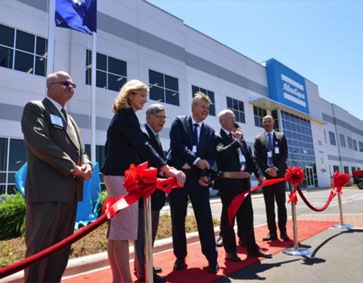 |
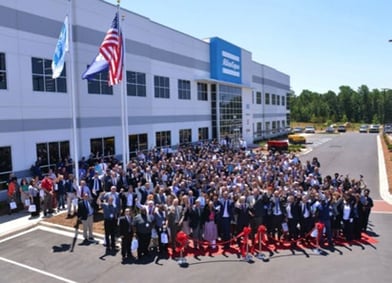 |
|
Atlas Copco President and CEO Mats Rahmstrom cuts the ribbon at the 2017 grand opening of the facility in Riverwalk Carolinas in Rock Hill, SC, celebrating $25 million in investment and 300 jobs. |
The celebration at the May2017 grand opening of the Atlas Copco facility in Riverwalk Carolinas in Rock Hill, SC. Riverwalk Carolinas is a mixed-use development that incorporates a “live, work, play” mentality. |
As the industrial market tightens and strategically located land becomes scarce, projects like Riverwalk Carolinas will be important to complete smart in-fill development. Because of the brownfield remediation, use of creative financing tools, and public support, the development has announced over $460 million and 927 jobs in the industrial park alone. Industrial tenants include McKesson, Physicians Choice Labs, Exel Distribution, Atlas Copco, and most recently NFL.
During the early stages of the Toyota-Mazda site search, the project went by the appropriate code name, “Project New World.” With highly publicized projects like Foxconn, Amazon’s HQ2, and Toyota- Mazda, it is indeed a new world as the protocol for capital investment projects is changing. The publicity is heightening the competition between regions, which means that communities must have vision and take ownership in their future to secure jobs and capital investment.
TRI-COUNTY INDUSTRIAL PARK: Sullivan County, Tennessee
Tri-County Industrial Park is a prime example of the advantages of using a regional approach to economic development. Community stakeholders in eastern Tennessee wanted to work together to create a new industrial park to create new jobs. A multi-jurisdictional group including Sullivan County, city of Johnson City, city of Elizabethton, and Carter County formed to develop a park. By forming this alliance, the group was able to pool resources, leverage regional assets, and utilize grant funding for site development costs.
The park was developed in the early 1970s using the following steps to bring local leaders’ vision to life:
- Preliminary Analysis of Available Land;
- Site Selection and Acquisition;
- Developmental Plan;
- Formulation of Restrictions and Controls of Property;
- Installation of Site;
- Improvements (Infrastructure);
- Building Construction;
- Management;
- BRE Programs; and
- Marketing of the Park.
After the site was developed, economic developers were intentional about marketing the property to local existing industries. Because they targeted existing employers, Bell Helicopter announced an expansion and became one of the anchor tenants of the industrial park.
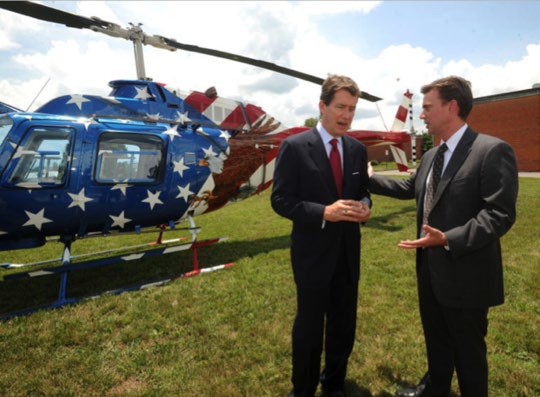 |
|
Tennessee Economic and Community Development Commissioner Bill Hagerty (left) and Chad Nimrick, Bell Helicopter general manager in Piney Flats, talk following a partnership agreement between Bell and Northeast State Community College. |
The percentage of dollars spent to establish the park among the four communities are as follows: Sullivan County (50 percent), city of Johnson City (25 percent), Elizabethton (12.5 percent), and Carter County (12.5 percent). The multi-jurisdictional approach has been extremely successful in bringing companies to the area. Tri-County Industrial Park is now home to over 20industrial tenants, which employ residents from all over the region.
A “NEW WORLD”
During the early stages of the Toyota-Mazda site search, the project went by the appropriate code name, “Project New World.” With highly publicized projects like Foxconn, Amazon’s HQ2, and Toyota-Mazda, it is indeed a new world as the protocol for capital investment projects is changing. The publicity is heightening the competition between regions, which means that communities must have vision and take ownership in their future to secure jobs and capital investment. For the communities in these case studies, the pay-off was well worth the risk; however, it is important to remember that development will not always (if ever) go exactly as planned. A key step in the site development process is to continually evaluate the strategic plan and not be afraid to pivot or evolve the project to meet the rapid changes of the marketplace.
If the site has potential, target the weaknesses of the property and determine the costs and schedule to mitigate these weaknesses. The short-comings of the site may be environmental contamination, wetlands present on-site, poor road access, uncooperative ownership groups, incompatible zoning, inadequate utility infrastructure, etc.
HOW CAN YOUR COMMUNITY START THE SITE DEVELOPMENT PROCESS?
Communities should look at the competitive landscape in which they operate and see what are the community assets and needs. If you feel that your community has the right characteristics (e.g. adequate labor pool, interstate access, etc.) to support an industrial park, the following basic steps can help get the development process started.
-
Conduct a site identification study to find a tract developable property with good transportation access. (The fewer property ownership groups and on-site impediments, the better!)
-
Gather utility and community stakeholders to assess whether the property’s infrastructure can meet the demands of an industrial park.
-
If the site has potential, target the weaknesses of the property and determine the costs and schedule to mitigate these weaknesses. The short-comings of the site may be environmental contamination, wetlands present on-site, poor road access, uncooperative ownership groups, incompatible zoning, inadequate utility infrastructure, etc.
-
Remember to manage the political process within your community. It will be important to make key stakeholders such as elected officials, state agencies, existing industries, utility providers, the media, property owners, school systems, neighbors, and the public feel included in the process.
-
Once you have a clear vision of the costs to develop the site and you have key stakeholders on-board, start identifying and securing sources of funding to assist with preparing the site.
-
Be cautious about proactively extending infrastructure. Consider whether the costs of extension will be overly burdensome or if infrastructure easements will break up contiguous, developable acreage.
-
Stay connected to the private developers in your community and gauge how your project may impact their efforts. Be sure not to duplicate efforts or “subsidize” the real estate market, which will discourage activity from local brokers and developers.
-
When the site is ready to be marketed to prospects, launch a marketing campaign and present the site information to the appropriate audience (state department of commerce agencies, real estate brokers, existing industries, site consultants, and directly to companies).
-
Continually evaluate the site development strategy to ensure the plan is in line with market demands. Do not be afraid to pivot and evolve the plan based on changes in the marketplace.
This article was originally published by The IEDC Economic Development Journal.
About Beth H. Land, CEcD
Beth H. Land, CEcD, is Vice President within the Industrial and Economic Development Division of Site Selection Group, a provider of global location advisory, economic incentive and corporate real estate services. You can reach her at bland@siteselectiongroup.com or at (214)271-0623.
About The IEDC
The International Economic Development Council (IEDC) is a non-profit, non-partisan membership organization serving economic developers. With more than 5,000 members, IEDC is the largest organization of its kind. Economic developers promote economic well-being and quality of life for their communities, by creating, retaining and expanding jobs that facilitate growth, enhance wealth and provide a stable tax base. From public to private, rural to urban and local to international, IEDC’s members are engaged in the full range of economic development experience. Given the breadth of economic development work, our members are employed in a wide variety of settings including local, state, provincial and federal governments, public-private partnerships, chambers of commerce, universities and a variety of other institutions. When we succeed, our members create high-quality jobs, develop vibrant communities, and improve the quality of life in their regions.
